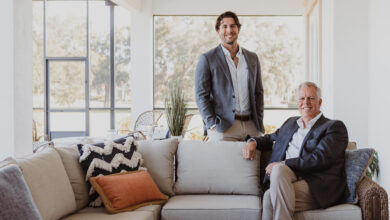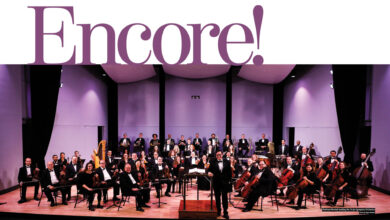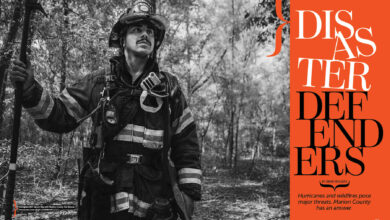By Nick Steele
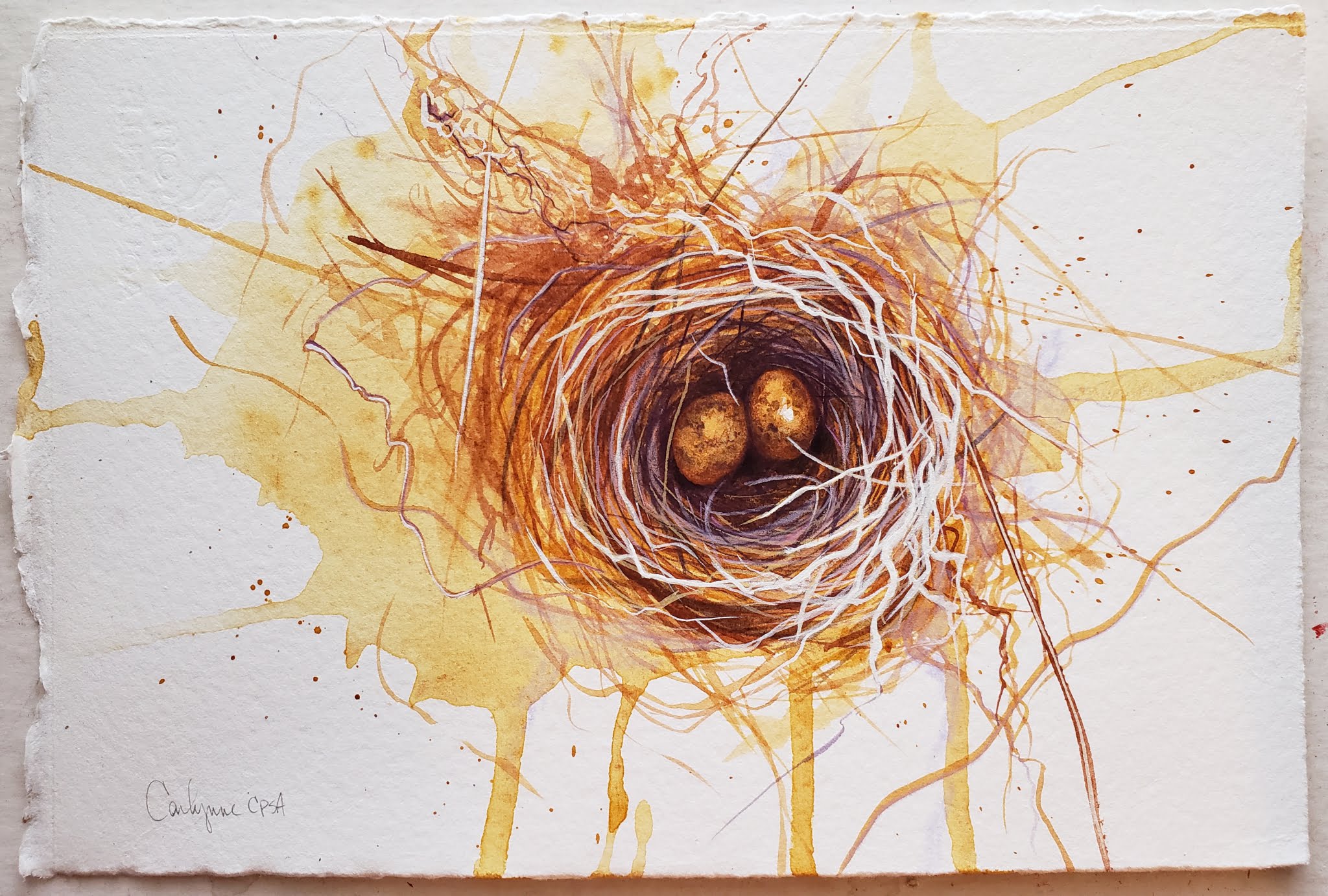
For Ocala-based artist Carlynne Hershberger, creativity runs in the family. “The art bug bit just about everyone in my family in some form or another. My mother paints, my grandmother painted, and my uncles and cousins have been involved in the arts,” she explains. “I remember visiting my great uncle and seeing the oil portraits he was working on; the smell of turpentine in his apartment; thinking how much I would love to get into those paint tubes. When I was little, my grandfather would ask me to draw cartoons from the Sunday comics. So I did that for him all the time. He was very encouraging.”
But her early passions were not limited to the funny papers. “According to my mother, I drew on the walls and furniture from the time I could hold a crayon,” she shares. “I remember art supplies being my absolute favorite thing in the world. I still remember the smell of my first box of 64 Crayola crayons. From kindergarten on up, all my favorite classes in school were art classes.”
From that point, her path as an artist was set and she began a period of exploration that led to her current style. “My first love was drawing, so I worked in graphite and colored pencil for 20 to 30 years. I gradually started adding other mediums. I worked in pastel, oil, acrylic, watercolor, and collage. Now I like to mix media,” she explains. “I mainly use acrylic on canvas but also add gold leaf. When I want to work on paper, I use watercolor combined with colored pencil and gouache.”
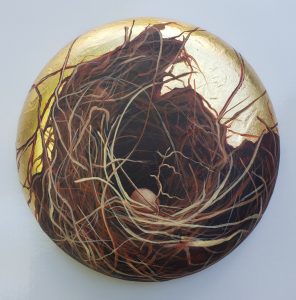
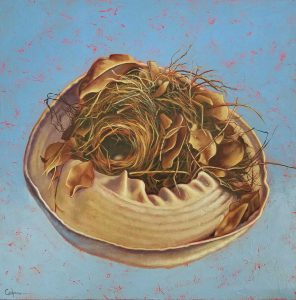
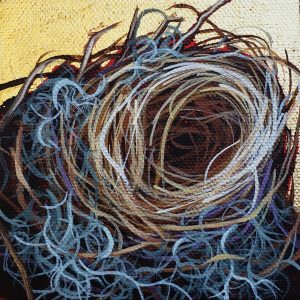
 Hershberger’s advice to anyone interested in pursuing a career in the arts is simple. “Whatever your thing is, do it and continue to do it. Build a strong body of work. Learn as much as possible. Take as many classes or workshops as possible. The main thing is the quality of the work. That comes first,” she offers. “Then think about selling. You have to put the time in. If there was a shortcut, I would’ve found it!”
Hershberger’s advice to anyone interested in pursuing a career in the arts is simple. “Whatever your thing is, do it and continue to do it. Build a strong body of work. Learn as much as possible. Take as many classes or workshops as possible. The main thing is the quality of the work. That comes first,” she offers. “Then think about selling. You have to put the time in. If there was a shortcut, I would’ve found it!”
Hershberger has certainly put the time in and has risen to prominence in our community through a combination of public art projects, displays of her fine art, and custom portrait commissions. You’ve probably even admired her life-sized painted pony Aggie, from the Marion Cultural Alliance (MCA) public-art project Horse Fever, which stands in front of City Hall. As an artist, it was an exciting and rewarding experience for both Hershberger and her husband Mark.
“Love Horse Fever!” she enthuses. “I painted three of the horses, one in each group. My husband also did three horses, and he sculpted the original “Horse Fever in Motion” figure and built all the horses that were painted in that group,” she continues. “We loved working on those. They were fun, challenging, and a great thing for Ocala. People come from all over to see the horses and take pictures with them. It also seemed to spark more interest in public art. Just look at where we are now with the sculptures at Tuscawilla Park and now we have the art park. It’s been a wonderful thing for us and the town.”
 Hershberger was also recently tapped by Ocala’s Community Cultural Arts Manager Laura Walker for another prominent public-art project. “Laura contacted me about painting the transformer on the square. It’s right across the street from the new Hilton building,” she explains. “It started out as a big, green electrical box—not that attractive—and they wanted to make something pretty to face the new hotel. We got together with Mike Zeak, from Zeak Technique (custom welding, fabrication, and restoration), and collaborated on the design. We wanted something that said Florida, so we came up with the palm fronds, and Mike did his design in the metal work fence around the box. I think our efforts worked well together and hopefully we’ll be able to do more in the future. Shouldn’t all transformer boxes be decorated? Towns everywhere have all these flat surfaces just waiting to be used as canvases.”
Hershberger was also recently tapped by Ocala’s Community Cultural Arts Manager Laura Walker for another prominent public-art project. “Laura contacted me about painting the transformer on the square. It’s right across the street from the new Hilton building,” she explains. “It started out as a big, green electrical box—not that attractive—and they wanted to make something pretty to face the new hotel. We got together with Mike Zeak, from Zeak Technique (custom welding, fabrication, and restoration), and collaborated on the design. We wanted something that said Florida, so we came up with the palm fronds, and Mike did his design in the metal work fence around the box. I think our efforts worked well together and hopefully we’ll be able to do more in the future. Shouldn’t all transformer boxes be decorated? Towns everywhere have all these flat surfaces just waiting to be used as canvases.”
And while she can get pretty excited at the prospect of transforming America’s electrical boxes into works of art, her passion project is her Nest series. “For me, the nest has deep personal meaning,” she explains. “But it can mean many things to many people. Recently someone actually asked me what it is that people see in the nest paintings, so I asked the question on my Facebook page,” she continues. “One person said hope, another said family. For some, it’s about bird watching or being a nature lover and for some, it may just mean springtime. My friend Cheryl Ritter said, ‘For me, they represent nature’s intriguing architecture. Built with determination, purpose, and adaptability.’ I thought that was a great answer, because since I began really studying the nests I’ve become more and more enchanted with birds and their abilities. In fact, if there’s such a thing as reincarnation, I want to come back as a bird, maybe a crow. They’re very smart. I don’t look for people to have a specific takeaway from the nests. If they’re drawn to them, they’re seeing something personal and that meaning could be as unique as each individual. That’s how it should be with any art. Everyone sees something different in it.”
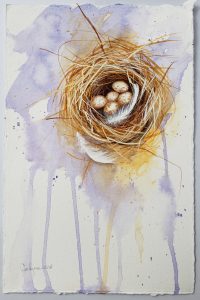 For the artist herself, her initial inspiration came in the form of a rather industrious lodger. “A wren began building a nest in my mailbox,” she recalls. “This happened for several years in a row and I got to watch the baby birds and see them fledge. After the nests were abandoned, I saved them when I cleaned out the mailbox. My interest in nests seemed like a logical progression of my work, since all my work is based in the natural world. I decided to paint the first one outside, just to explore it as part of my landscape work. I enjoyed it so much I did another and then another. People began to respond to them and I’m still intrigued by them so I guess I’ll be painting them for a while. I’ve also collected quite a few nests. I’ve been gifted nests by friends and relatives when they find them, so now I have a corner of my studio that’s filled with them. It’s great; I always have a reference on hand.”
For the artist herself, her initial inspiration came in the form of a rather industrious lodger. “A wren began building a nest in my mailbox,” she recalls. “This happened for several years in a row and I got to watch the baby birds and see them fledge. After the nests were abandoned, I saved them when I cleaned out the mailbox. My interest in nests seemed like a logical progression of my work, since all my work is based in the natural world. I decided to paint the first one outside, just to explore it as part of my landscape work. I enjoyed it so much I did another and then another. People began to respond to them and I’m still intrigued by them so I guess I’ll be painting them for a while. I’ve also collected quite a few nests. I’ve been gifted nests by friends and relatives when they find them, so now I have a corner of my studio that’s filled with them. It’s great; I always have a reference on hand.”
There was, however, another more personal catalyst for the series. It is an exploration of coerced and unethical adoptions, from a birth mother’s point of view. “That first nest, that I painted, was part of my Silent Voices series,” she explains. “The series is about the view of a mother whose child was surrendered at birth in a forced adoption—about living with infant adoption from my point of view. It began as a form of therapy for me, a way of working through the trauma and healing,” she continues. “There are so many people affected by adoption, but the first mother’s view is seldom seen. I’m afraid that series does upset some people because it goes against the usual happy adoption narrative. It can be a difficult subject, but it can open up discussion about a reality that many don’t realize exists. Silent Voices is also an ongoing project. I’ve had one exhibit with those paintings in Georgia. I’d like to have another, maybe closer to home. My ultimate dream is to have a museum show with it someday. I also have a book, available through Amazon, with some of the paintings and narrative poetry that I wrote to go with them.”
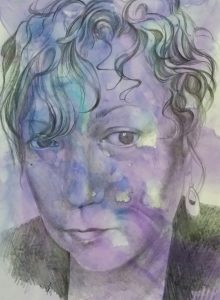 Hershberger is also often engaged to create custom commissioned portraits. “When I do portraits, I usually go back to my first love…colored pencil,” she explains. “I like the control and amount of detail I get with a pencil. I do children’s portraits mainly. They’re more fun than grown-ups. If possible I like to take photos of the subjects myself or I’ll work with the client’s photos. I’ll go over the pictures with the clients to choose the best one. For many of them, I like to work on colored paper. Different colors can set a mood and really enhance the portrait. I really prefer candid shots to work from because that’s when you see the child’s personality come through. It’s a real joy to bring that little face to life on paper.”
Hershberger is also often engaged to create custom commissioned portraits. “When I do portraits, I usually go back to my first love…colored pencil,” she explains. “I like the control and amount of detail I get with a pencil. I do children’s portraits mainly. They’re more fun than grown-ups. If possible I like to take photos of the subjects myself or I’ll work with the client’s photos. I’ll go over the pictures with the clients to choose the best one. For many of them, I like to work on colored paper. Different colors can set a mood and really enhance the portrait. I really prefer candid shots to work from because that’s when you see the child’s personality come through. It’s a real joy to bring that little face to life on paper.”
Her drive to capture that sort of authenticity in her work can also be witnessed in her paintings of the natural world. “There’s just so much I want to paint. Mother Nature keeps inspiring me,” she offers. “We need to keep our connection to nature, learn from it and protect it. For me, painting is how I stay connected.”
Hershberger recently staged a three-month exhibition at City Hall, and her work is frequently included in the MCA member shows. A few of her pieces are available through the MCA gift shop. She will also be part of some upcoming group shows at Blackbird Farm and Studio in Micanopy (micanopyblackbird.com). She is represented by Signature Art Gallery in Tallahassee and Macon Arts in Macon, Georgia. For more information, visit carlynnehershberger.com.


